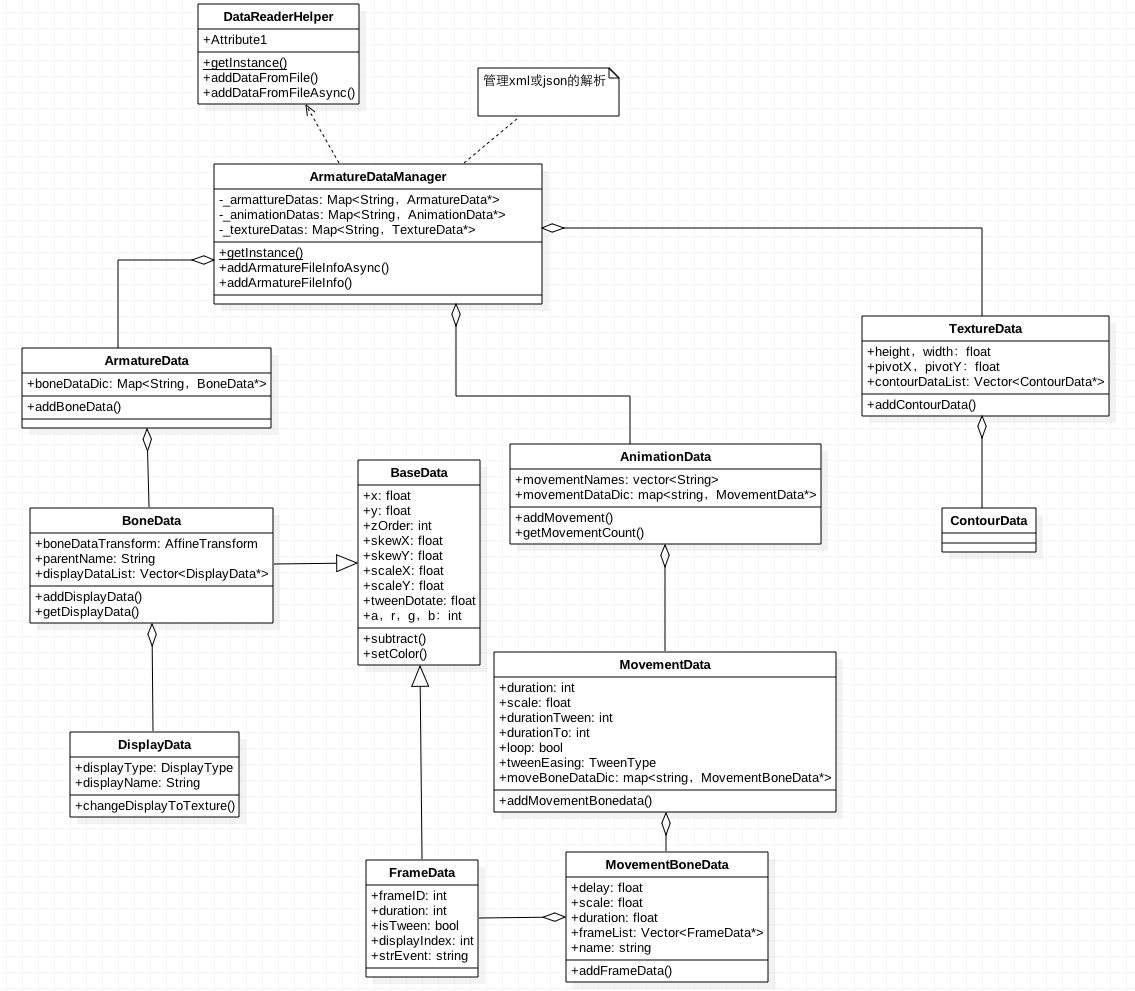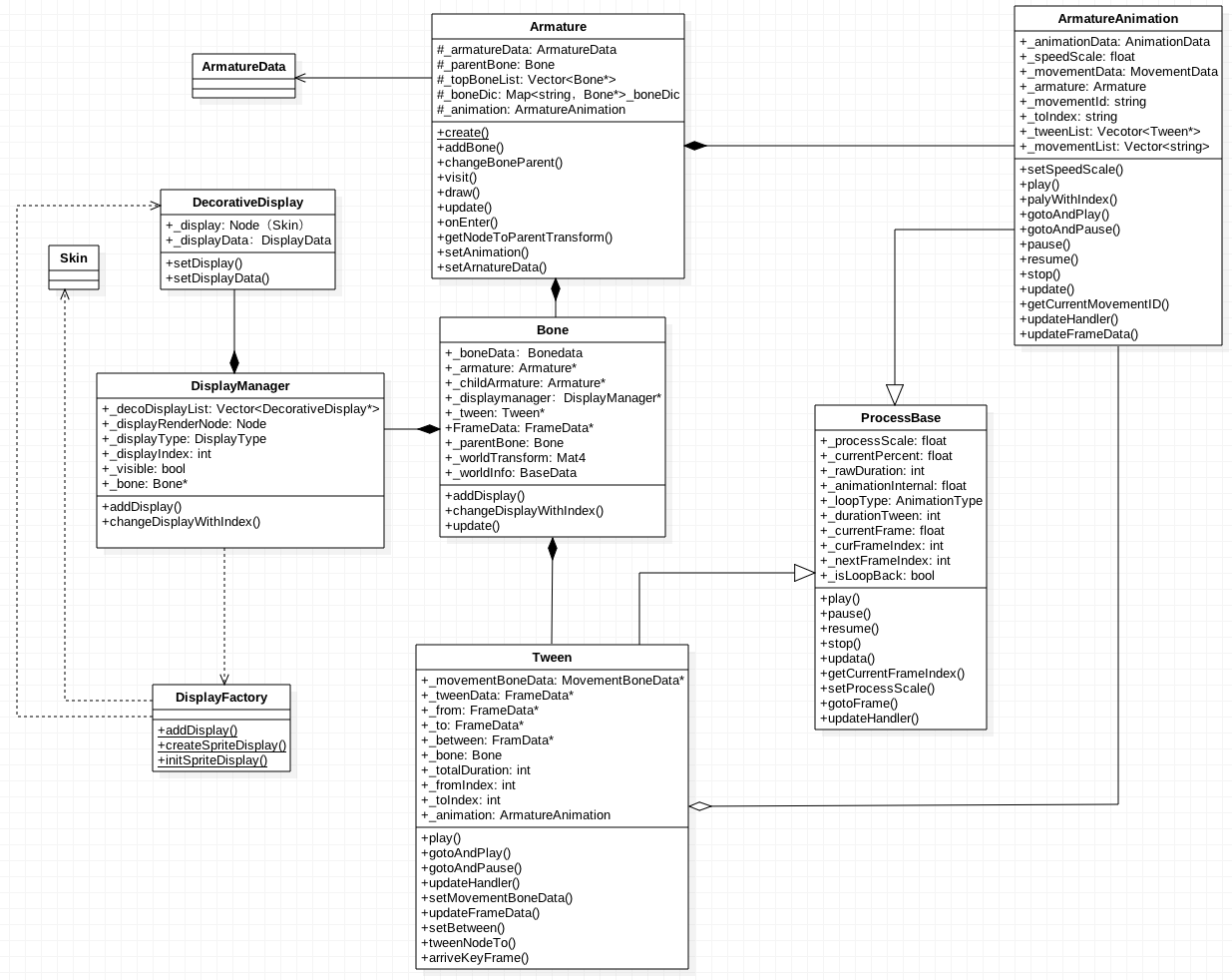cocos2dx裡骨骼動畫代碼在cocos -> editor-support -> cocostudio文件夾中,win下通過篩選器,文件結構如下。(mac下沒有分,是整個一坨)
armature(目錄): animation(目錄):動畫控制相關。 CCProcessBase(文件): ProcessBase(類):CCTween和ArmatureAnimation的基類。 CCTWeen(文件): Tween(類):控制flash裡一個layer的動畫。 CCArmatureAnimation(文件): ArmatureAnimation(類):控制整個動畫,內有多個Tween。 datas(目錄):xml或json轉成c++中直接用的數據結構。 CCDatas(文件): BaseData(類):BoneData、FrameData的基類,包含大小位置顏色等信息。 DisplayData(類): SpriteDisplayData、ArmatureDisplayData、ParticleDisplayData的基類。 SpriteDisplayData(類):骨骼中的顯示數據。 ArmatureDisplayData(類): ParticleDisplayData(類): BoneData(類):單個骨骼數據,flash中一個layer是一個骨骼。 ArmatureData(類):骨骼數據,整個骨骼結構數據。 FrameData(類):關鍵幀數據。 MovementBoneData(類):帶有關鍵幀的骨骼數據。 MovementData(類):一個完整動畫數據。 AnimationData(類):組動畫數據,包含多個MovementData。 ContourData(類): TextureData(類):顯示圖片數據。 utils(目錄): CCArmatureDataManager(文件): RelativeData(類): ArmatureDataManager(類):管理ArmatureData、AnimationData、TextureData。 CCArmatureDefine(文件): CCDataReaderHelper(文件): _AsyncStruct(類): _DataInfo(類): DataReaderHelper(類):這正解析xml或json的類。 CCSpriteFrameCacheHelper(文件): SpriteFrameCacheHelper(類): CCTransformHelp(文件): TransformHelp(類):矩陣運算。 CCUtilMath(文件): CCArmature(文件): Armature(類):控制整個骨骼動畫,內有ArmatureAnimation和ArmatureData。 CCBone(文件): Bone(類):骨骼控制類 display(目錄):顯示的圖片管理。 CCBatchNode(文件): BatchNode(類): CCDecorativeDisplay(文件): DecorativeDisplay(類): CCDisplayFactory(文件): DisplayFactory(類): CCDisplayManager(文件): DisplayManager(類): CCSkin(文件): Skin(類): physics(目錄):物理引擎相關,不分析。 ColliderFilter(文件): ColliderFilter(類): ColliderBody(類): ColliderDetecotor(類)
數據相關源碼
從底層到高層分析一個類一個類分析
再來看下數據相關的UML,總體來說,就是ArmatureDataManager依賴DataReaderHelper把flash導出的xml文件解析成程序直接用的XXData,XXData對應於xml的某個節點,比如FrameData就對應於<f>節點(<animaton><mov><b><f>)。

BaseData
BaseData:用來表示骨骼或幀的位置、旋轉、顏色、縮放。
BaseData.h
class BaseData : public cocosd::Ref
{
public:
//Calculate two BaseData's between value(to - from) and set to self
virtual void subtract(BaseData *from, BaseData *to, bool limit);
public:
//位置,xml的x,y
float x;
float y;
//xml中z
int zOrder;
//旋轉,xml的kX,kY
float skewX;
float skewY;
//縮放,xml的cX,cY
float scaleX;
float scaleY;
//啥??
float tweenRotate;
//顏色的變化屬性
bool isUseColorInfo;
int a, r, g, b;
};
作為FrameData和BoneData的基類,提供骨骼的狀態信息。從下文可知BoneData對應xml中的<armature<b>>中的b節點,FrameData對應xml中的<f>節點,BoneData和FrameData都有
<x,y,kX,kY,cX,cY,pX,pY,z>等屬性,BaseDa代表了這些屬性。
BoneData
BoneData對應xml中的<armature<b>>中的b節點
class BoneData : public BaseData
{
public:
void addDisplayData(DisplayData *displayData);
DisplayData *getDisplayData(int index);
public:
std::string name; //! the bone's name
std::string parentName; //! the bone parent's name
//! save DisplayData informations for the Bone
cocosd::Vector<DisplayData*> displayDataList;
//仿射變換,程序裡好像沒用這個屬性
cocosd::AffineTransform boneDataTransform;
};
BoneData裡有displayDataList,用來放這個骨頭上的皮膚(就是DisplayData), DisplayData對應xml節點中的<b<d>>節點,一個BoneData裡可以有多個皮膚,換裝等功能需要多個皮膚。
FrameData
FrameData對應xml中的<f>節點,就是flash裡的關鍵幀信息。
class FrameData : public BaseData
{
public:
int frameID;
//xml中dr,這一幀長度
int duration;
//不知要他干啥
bool isTween;
//xml中dI,顯示哪個圖
int displayIndex;
};
DisplayData
DisplayData是SpriteDisplayData、ArmatureDisplayData、ParticleDisplayData的父類,用來表示展示節點信息。
ArmatureData
ArmatureData是對應<armature>節點,裡面有這個骨骼的所有骨頭,可以看成骨骼動畫的骨骼。
class ArmatureData : public cocosd::Ref
{
public:
//添加骨骼信息
void addBoneData(BoneData *boneData);
BoneData *getBoneData(const std::string& boneName);
public:
std::string name;
//多個骨頭信息
cocosd::Map<std::string, BoneData*> boneDataDic;
float dataVersion;
};
AnimationData
AnimationData對應<animation>節點,裡面有多個MovementData,MovementData(下面介紹)對應xml中的mov,為flash中的一個帶幀標簽的動畫。
class AnimationData : public cocosd::Ref
{
public:
void addMovement(MovementData *movData);
MovementData *getMovement(const std::string& movementName);
ssize_t getMovementCount();
public:
//<animation name="Dragon">中的name
std::string name;
//所有帶幀標簽的動畫map
cocosd::Map<std::string, MovementData*> movementDataDic;
//所有帶幀標簽的動畫名
std::vector<std::string> movementNames;
};
MovementData
MovementData對應xml中<animation<mov>>, 其中有所有的帶幀信息的骨骼MovementBoneData(mov中的b)。
class MovementData : public cocosd::Ref
{
public:
void addMovementBoneData(MovementBoneData *movBoneData);
MovementBoneData *getMovementBoneData(const std::string& boneName);
public:
std::string name;
//xml 中 dr
int duration;
//這怎麼有個scale??
float scale;
//xml中to
int durationTo;
//xml中drTW
int durationTween;
//xml中lp
bool loop;
//帶幀信息的骨骼
cocosd::Map<std::string, MovementBoneData*> movBoneDataDic;
};
MovementBoneData
MovementBoneData對應xml中<mov<b>>的b,裡面有frameList,即為關鍵幀信息。
class MovementBoneData : public cocosd::Ref
{
void addFrameData(FrameData *frameData);
FrameData *getFrameData(int index);
public:
//xml中的dl
float delay;
//xml中的sc
float scale;
//這個和MovementData中的duration是不是一個??
float duration;
std::string name;
//關鍵幀信息
cocosd::Vector<FrameData*> frameList;
};
小總結
xml中的各個節點和XXData的對應關系如下表,xml各個字段的意義可以參考上篇文章

再來看產生動畫相關的代碼

ArmatureDataManager
ArmatureDataManager利用DataReaderHelper解析出armarureDatas、animationDatas和_textureDatas。
ArmatureDataManager是個單例,用到動畫時會到ArmatureDataManager取得要生成動畫的數據。
class ArmatureDataManager : public cocosd::Ref
{
public:
//單例
static ArmatureDataManager *getInstance();
static void destroyInstance();
public:
void addArmatureData(const std::string& id, ArmatureData *armatureData, const std::string& configFilePath = "");
ArmatureData *getArmatureData(const std::string& id);
void removeArmatureData(const std::string& id);
void addAnimationData(const std::string& id, AnimationData *animationData, const std::string& configFilePath = "");
AnimationData *getAnimationData(const std::string& id);
void removeAnimationData(const std::string& id);
void addTextureData(const std::string& id, TextureData *textureData, const std::string& configFilePath = "");
TextureData *getTextureData(const std::string& id);
void removeTextureData(const std::string& id);
void addArmatureFileInfo(const std::string& configFilePath);
const cocosd::Map<std::string, ArmatureData*>& getArmatureDatas() const;
const cocosd::Map<std::string, AnimationData*>& getAnimationDatas() const;
const cocosd::Map<std::string, TextureData*>& getTextureDatas() const;
protected:
void addRelativeData(const std::string& configFilePath);
RelativeData *getRelativeData(const std::string& configFilePath);
private:
cocosd::Map<std::string, ArmatureData*> _armarureDatas;
cocosd::Map<std::string, AnimationData*> _animationDatas;
cocosd::Map<std::string, TextureData*> _textureDatas;
std::unordered_map<std::string, RelativeData> _relativeDatas;
};
主要就是armarureDatas、animationDatas、_textureDatas三個map,那這三個map是怎麼產生的呢?當執行
ArmatureDataManager::getInstance()->addArmatureFileInfo(“dragon.xml”);
後,那三個map變生成了。addArmatureFileInfo代碼如下
void ArmatureDataManager::addArmatureFileInfo(const std::string& configFilePath)
{
addRelativeData(configFilePath);
_autoLoadSpriteFile = true;
DataReaderHelper::getInstance()->addDataFromFile(configFilePath);
}
又調用了DataReaderHelper::getInstance()->addDataFromFile(),可知是DataReaderHelper真正完成了數據的解析。
DataReaderHelper類裡有一堆decodeXXX()(比如decodeArmature、decodeBone)解析xml的某個節點。看下
addDataFromFile這個代碼:
void DataReaderHelper::addDataFromFile(const std::string& filePath)
{
//省略一些代碼
DataInfo dataInfo;
dataInfo.filename = filePathStr;
dataInfo.asyncStruct = nullptr;
dataInfo.baseFilePath = basefilePath;
if (str == ".xml")
{
DataReaderHelper::addDataFromCache(contentStr, &dataInfo);
}
else if(str == ".json" || str == ".ExportJson")
{
DataReaderHelper::addDataFromJsonCache(contentStr, &dataInfo);
}
else if(isbinaryfilesrc)
{
DataReaderHelper::addDataFromBinaryCache(contentStr.c_str(),&dataInfo);
}
CC_SAFE_DELETE_ARRAY(pBytes);
}
對應不同的文件(xml、json、二進制)解析方式,xml用到是addDataFromCache
void DataReaderHelper::addDataFromCache(const std::string& pFileContent, DataInfo *dataInfo)
{
tinyxml::XMLDocument document;
document.Parse(pFileContent.c_str());
tinyxml::XMLElement *root = document.RootElement();
CCASSERT(root, "XML error or XML is empty.");
root->QueryFloatAttribute(VERSION, &dataInfo->flashToolVersion);
/*
* Begin decode armature data from xml
*/
tinyxml::XMLElement *armaturesXML = root->FirstChildElement(ARMATURES);
tinyxml::XMLElement *armatureXML = armaturesXML->FirstChildElement(ARMATURE);
while(armatureXML)
{
ArmatureData *armatureData = DataReaderHelper::decodeArmature(armatureXML, dataInfo);
if (dataInfo->asyncStruct)
{
_dataReaderHelper->_addDataMutex.lock();
}
ArmatureDataManager::getInstance()->addArmatureData(armatureData->name.c_str(), armatureData, dataInfo->filename.c_str());
armatureData->release();
if (dataInfo->asyncStruct)
{
_dataReaderHelper->_addDataMutex.unlock();
}
armatureXML = armatureXML->NextSiblingElement(ARMATURE);
}
/*
* Begin decode animation data from xml
*/
tinyxml::XMLElement *animationsXML = root->FirstChildElement(ANIMATIONS);
tinyxml::XMLElement *animationXML = animationsXML->FirstChildElement(ANIMATION);
while(animationXML)
{
AnimationData *animationData = DataReaderHelper::decodeAnimation(animationXML, dataInfo);
if (dataInfo->asyncStruct)
{
_dataReaderHelper->_addDataMutex.lock();
}
ArmatureDataManager::getInstance()->addAnimationData(animationData->name.c_str(), animationData, dataInfo->filename.c_str());
animationData->release();
if (dataInfo->asyncStruct)
{
_dataReaderHelper->_addDataMutex.unlock();
}
animationXML = animationXML->NextSiblingElement(ANIMATION);
}
/*
* Begin decode texture data from xml
*/
tinyxml::XMLElement *texturesXML = root->FirstChildElement(TEXTURE_ATLAS);
tinyxml::XMLElement *textureXML = texturesXML->FirstChildElement(SUB_TEXTURE);
while(textureXML)
{
TextureData *textureData = DataReaderHelper::decodeTexture(textureXML, dataInfo);
if (dataInfo->asyncStruct)
{
_dataReaderHelper->_addDataMutex.lock();
}
ArmatureDataManager::getInstance()->addTextureData(textureData->name.c_str(), textureData, dataInfo->filename.c_str());
textureData->release();
if (dataInfo->asyncStruct)
{
_dataReaderHelper->_addDataMutex.unlock();
}
textureXML = textureXML->NextSiblingElement(SUB_TEXTURE);
}
}
裡面有三個while,分別decodeArmature、decodeAnimation、decodeTexture,生成ArmatureData、AnimationData、TextureData之後又ArmatureDataManager::getInstance()->addArmatureData、addAnimationData、addTextureData,加到ArmatureDataManager對應map裡。decodeXXX裡又會調用各種decodeXX來生成相應的XXXData。
Armature
在載入了xml數據後,調用
armature = Armature::create("Dragon");
armature->getAnimation()->play("walk");
armature->getAnimation()->setSpeedScale();
armature->setPosition(VisibleRect::center().x, VisibleRect::center().y * .f);
armature->setScale(.f);
addChild(armature);
便展示了動畫,那麼這是如何做到的呢?
Armature部分代碼如下,ArmatureAnimation控制xml的mov節點,Bone中有Tween,這個Tween對應xml中b(MovementBoneData)
class Armature: public cocosd::Node, public cocosd::BlendProtocol {
protected:
//要展示動畫的ArmatureData
ArmatureData *_armatureData;
BatchNode *_batchNode;
Bone *_parentBone;
float _version;
mutable bool _armatureTransformDirty;
//所有Bone
cocosd::Map<std::string, Bone*> _boneDic; cocosd::Vector<Bone*> _topBoneList;
cocosd::BlendFunc _blendFunc;
cocosd::Vec _offsetPoint;
cocosd::Vec _realAnchorPointInPoints;
//動畫控制器
ArmatureAnimation *_animation;
};
Bone
部分代碼如下,tweenData為當前Bone的狀態,每幀都會更新這個值,並用tweenData確定worldInfo,提供Skin顯示信息。tween為骨頭的整個動畫過程。
class Bone: public cocosd::Node {
protected:
BoneData *_boneData;
//! A weak reference to the Armature
Armature *_armature;
//! A weak reference to the child Armature
Armature *_childArmature;
DisplayManager *_displayManager;
/*
* When Armature play an animation, if there is not a MovementBoneData of this bone in this MovementData, this bone will be hidden.
* Set IgnoreMovementBoneData to true, then this bone will also be shown.
*/
bool _ignoreMovementBoneData;
cocosd::BlendFunc _blendFunc;
bool _blendDirty;
Tween *_tween; //! Calculate tween effect
//! Used for making tween effect in every frame
FrameData *_tweenData;
Bone *_parentBone; //! A weak reference to its parent
bool _boneTransformDirty; //! Whether or not transform dirty
//! self Transform, use this to change display's state
cocosd::Mat _worldTransform;
BaseData *_worldInfo;
//! Armature's parent bone
Bone *_armatureParentBone;
};
Tween
這個是每個骨頭的動畫過程,見下面的movementBoneData。tweenData是Bone中tweenData的引用,在這每幀會計算這個tweenData值。
class Tween : public ProcessBase{
protected:
//! A weak reference to the current MovementBoneData. The data is in the data pool
MovementBoneData *_movementBoneData;
FrameData *_tweenData; //! The computational tween frame data, //! A weak reference to the Bone's tweenData
FrameData *_from; //! From frame data, used for calculate between value
FrameData *_to; //! To frame data, used for calculate between value
// total diff guan
FrameData *_between; //! Between frame data, used for calculate current FrameData(m_pNode) value
Bone *_bone; //! A weak reference to the Bone
TweenType _frameTweenEasing; //! Dedermine which tween effect current frame use
int _betweenDuration; //! Current key frame will last _betweenDuration frames
// 總共運行了多少幀 guan
int _totalDuration;
int _fromIndex; //! The current frame index in FrameList of MovementBoneData, it's different from m_iFrameIndex
int _toIndex; //! The next frame index in FrameList of MovementBoneData, it's different from m_iFrameIndex
ArmatureAnimation *_animation;
bool _passLastFrame; //! If current frame index is more than the last frame's index
};
ArmatureAnimation
控制動畫的播放,看到_tweenList,所有骨頭的集合就是動畫了。
class ArmatureAnimation : public ProcessBase {
protected:
//! AnimationData save all MovementDatas this animation used.
AnimationData *_animationData;
MovementData *_movementData; //! MovementData save all MovementFrameDatas this animation used.
Armature *_armature; //! A weak reference of armature
std::string _movementID; //! Current movment's name
int _toIndex; //! The frame index in MovementData->m_pMovFrameDataArr, it's different from m_iFrameIndex.
cocos2d::Vector<Tween*> _tweenList;
}
如何做到每幀更新骨頭的信息?
addChild(armature)後,Armaure中的onEnter(node進入舞台就會調用,比如addchild),onEnter調scheduleUpdate調scheduleUpdateWithPriority調_scheduler->scheduleUpdate。這樣就每幀調用armature的update。
void Armature::update(float dt)
{
_animation->update(dt);
for(const auto &bone : _topBoneList) {
bone->update(dt);
}
_armatureTransformDirty = false;
}
又調用了animation->update(dt);及遍歷調用bone->update(dt);animation->update(dt)如下:
void ArmatureAnimation::update(float dt)
{
ProcessBase::update(dt);
for (const auto &tween : _tweenList)
{
tween->update(dt);
}
//省略一堆代碼
}
又調用了tween->update(dt); 每一個update都會調用updateHandler(ProcessBase中update調用了update裡調用updateHandler)
void Tween::updateHandler()
{
//省略一堆代碼
if (_loopType > ANIMATION_TO_LOOP_BACK)
{
percent = updateFrameData(percent);
}
if(_frameTweenEasing != ::cocosd::tweenfunc::TWEEN_EASING_MAX)
{
tweenNodeTo(percent);
}
}
tweenNodeTo調用了tweenNodeTo,其中的tweenData其實就是Bone的tweenData。根據percent計算了_tweenData的變化量。
FrameData *Tween::tweenNodeTo(float percent, FrameData *node)
{
node = node == nullptr ? _tweenData : node;
if (!_from->isTween)
{
percent = ;
}
node->x = _from->x + percent * _between->x;
node->y = _from->y + percent * _between->y;
node->scaleX = _from->scaleX + percent * _between->scaleX;
node->scaleY = _from->scaleY + percent * _between->scaleY;
node->skewX = _from->skewX + percent * _between->skewX;
node->skewY = _from->skewY + percent * _between->skewY;
_bone->setTransformDirty(true);
if (node && _between->isUseColorInfo)
{
tweenColorTo(percent, node);
}
return node;
}
轉了一大圈終於在每幀更新了Bone中的tweenData,最後看Bone的update,其根據tweenData計算了worldInfo、worldTransform。而且updateDisplay更新skin的信息,staticcast<skin*>(display)->updateArmatureTransform();再transform = TransformConcat(_bone->getNodeToArmatureTransform(), _skinTransform);
void Bone::update(float delta)
{
if (_parentBone)
_boneTransformDirty = _boneTransformDirty || _parentBone->isTransformDirty();
if (_armatureParentBone && !_boneTransformDirty)
{
_boneTransformDirty = _armatureParentBone->isTransformDirty();
}
if (_boneTransformDirty)
{
if (_dataVersion >= VERSION_COMBINED)
{
TransformHelp::nodeConcat(*_tweenData, *_boneData);
_tweenData->scaleX -= ;
_tweenData->scaleY -= ;
}
_worldInfo->copy(_tweenData);
_worldInfo->x = _tweenData->x + _position.x;
_worldInfo->y = _tweenData->y + _position.y;
_worldInfo->scaleX = _tweenData->scaleX * _scaleX;
_worldInfo->scaleY = _tweenData->scaleY * _scaleY;
_worldInfo->skewX = _tweenData->skewX + _skewX + _rotationZ_X;
_worldInfo->skewY = _tweenData->skewY + _skewY - _rotationZ_Y;
if(_parentBone)
{
applyParentTransform(_parentBone);
}
else
{
if (_armatureParentBone)
{
applyParentTransform(_armatureParentBone);
}
}
TransformHelp::nodeToMatrix(*_worldInfo, _worldTransform);
if (_armatureParentBone)
{
_worldTransform = TransformConcat(_worldTransform, _armature->getNodeToParentTransform());
}
}
DisplayFactory::updateDisplay(this, delta, _boneTransformDirty || _armature->getArmatureTransformDirty());
for(const auto &obj: _children) {
Bone *childBone = static_cast<Bone*>(obj);
childBone->update(delta);
}
_boneTransformDirty = false;
如何展示(draw)出圖片(skin)
Armature詩歌node,加入父節點後會調用其draw函數,遍歷draw了bone的顯示元素。
void Armature::draw(cocosd::Renderer *renderer, const Mat &transform, uint_t flags)
{
if (_parentBone == nullptr && _batchNode == nullptr)
{
// CC_NODE_DRAW_SETUP();
}
for (auto& object : _children)
{
if (Bone *bone = dynamic_cast<Bone *>(object))
{
Node *node = bone->getDisplayRenderNode();
if (nullptr == node)
continue;
switch (bone->getDisplayRenderNodeType())
{
case CS_DISPLAY_SPRITE:
{
Skin *skin = static_cast<Skin *>(node);
skin->updateTransform();
BlendFunc func = bone->getBlendFunc();
if (func.src != _blendFunc.src || func.dst != _blendFunc.dst)
{
skin->setBlendFunc(bone->getBlendFunc());
}
else
{
skin->setBlendFunc(_blendFunc);
}
skin->draw(renderer, transform, flags);
}
break;
case CS_DISPLAY_ARMATURE:
{
node->draw(renderer, transform, flags);
}
break;
default:
{
node->visit(renderer, transform, flags);
// CC_NODE_DRAW_SETUP();
}
break;
}
}
else if(Node *node = dynamic_cast<Node *>(object))
{
node->visit(renderer, transform, flags);
// CC_NODE_DRAW_SETUP();
}
}
}
再skin->draw(renderer, transform, flags);會用到剛剛更新的_quad,顯示出最新的圖片信息。
{
Mat mv = Director::getInstance()->getMatrix(MATRIX_STACK_TYPE::MATRIX_STACK_MODELVIEW);
//TODO implement z order
_quadCommand.init(_globalZOrder, _texture->getName(), getGLProgramState(), _blendFunc, &_quad, , mv);
renderer->addCommand(&_quadCommand);
}
至此,大家對cocos2dx裡的骨骼動畫應該有了全面的認識,三篇文章介紹的比較粗糙,其實有些細節內容我也沒看懂,不過不要在意這些細節,沒有實際的改動需求的話,懂80%就可以了,細節可以需要的時候在仔細理解。
相關文章
- background-color設置與代碼簡寫
- text-decoration:line-through CSS文字中劃線 刪除線 貫穿線樣式
- HTMl5的存儲方式sessionStorage和localStorage詳解
- Ajax跨域訪問Cookie丟失問題的解決方法
- Ajax 設置Access-Control-Allow-Origin實現跨域訪問
- jquery插件ContextMenu設置右鍵菜單
- jQuery插件ContextMenu自定義圖標
- jQuery插件FusionCharts繪制ScrollColumn2D圖效果示例【附demo源碼下載】
- 使用JavaScriptCore實現OC和JS交互詳解
- JavaScript裝飾器函數(Decorator)實例詳解